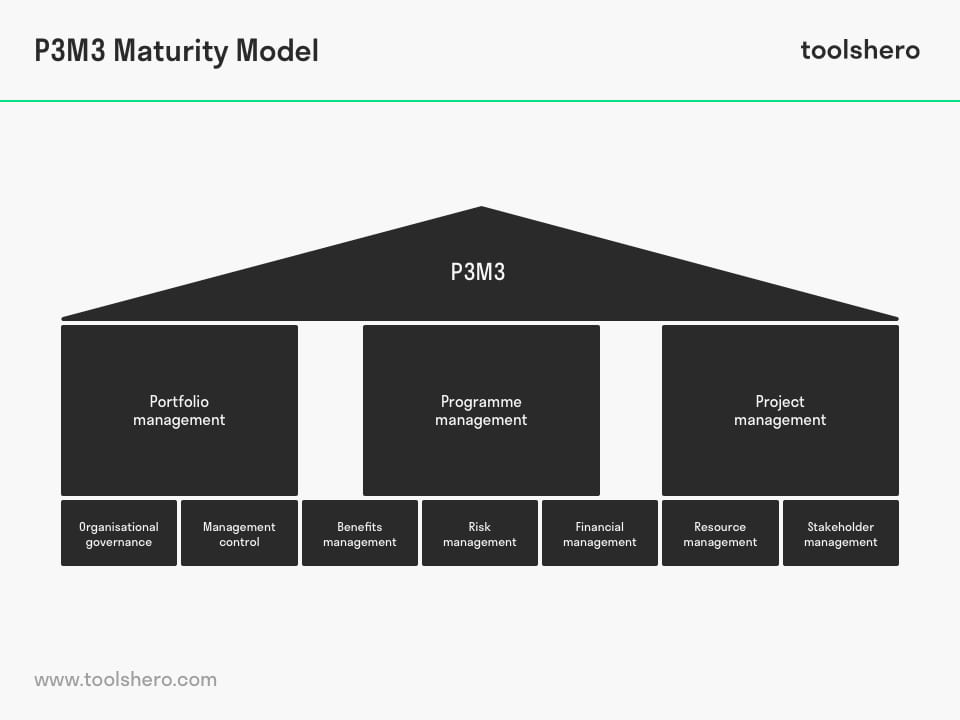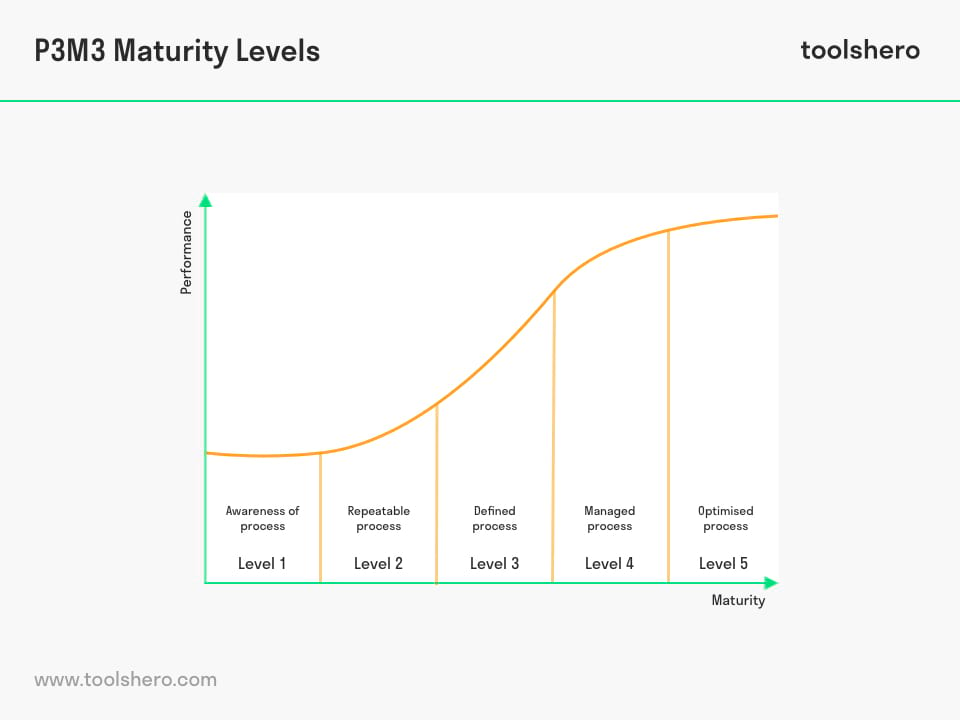P3M3 Maturity Model

This article explains the concept of the P3M3 Maturity Model, or the Portfolio, Programme & Project Management Maturity Model, in a practical way. After reading it, you will understand the basics of this powerful project management tool.
What is the P3M3 Maturity Model?
There is a common misconception within project management by wanting to view it from a tactical business perspective. However, projects are financial investments made by the organisation. This is why it’s wise to not just focus on a department level, but also look at the big picture to see the strategic motivation behind it.
The Portfolio, Programme & Project Management Maturity Model is known as a revolutionary strategic project management model that provides insight into this process in useful ways. It’s also called SPM3; Strategic Project Management Maturity Model. It ensures a practical use of project management and ensures that the right projects are being worked on. P3M3 is managed by AXELOS.
The model is used to evaluate the management maturity of an organisation. P3M3 organises, structures, and measures specific organisational activities in a simple and practical way. This helps organisations better understand how project management can be implemented on a tactical level from a strategic perspective.
This doesn’t just help departments, but the organisation as a whole. It enables the organisation to develop and improve more effectively.
P3M3 Maturity Model: maturity
P3M3 contains five increasing levels of maturity. That’s where the model gets its name. Within each level there are processes, procedures, tools, and behaviours that contribute to the overall strategic objectives of the organisation.
Additionally, it focuses on the implementation from a strategic perspective of the organisation. This organisational perspective is key.
Developments in project management will also help improve results. This benefits the entire organisation. From a common insight, the organisation can then define and realise improvement objectives. After all, project management maturity is focused on starting, carrying out, and completing projects within an organisation, with the goal to get good results.
SPM3 / P3M3 advantages
Working with SPM3/P3M3 has many advantages. First of all, it lets you compare your organisation to other organisations with an independent market standard.
Nor is the focus entirely on knowledge within the business. Instead it’s mostly about implementing strategic ideas and how to carry them out. These ideas can then be translated to the tactical department level much more easily, which helps to make everyone in the organisation feel like they’re a part of it.
All layers of a business will have a shared insight into the improvement initiatives that will eventually lead to the best results.
P3M3 : From a tactical to a strategic level
In general, project management maturity models focus on how well a certain organisation carries out the tactical aspects of project management. However, it’s important to create a better link between strategic and tactical management.
While planning and control is a task of the tactical management, it would be almost impossible for them to decide on a direction without a strategy. The employees involved with project management will have to know at an early stage which project ideas are floating around and which decisions have been made.
By involving them, they will be driven to facilitate the project and monitor progress. Eventually this will lead to a higher business impact, and they will feel a shared responsibility for the end results.
P3M3 maturity levels
P3M3 (Portfolio, Programme & Project Management Maturity Model) has the following five maturity levels within organisations:
Level 1: Awareness
The awareness process that consists of defining an organisation’s strategic intention. This is where the organisation can use a GAP Analysis or a Balanced Scorecard, which usually reveals the long-term, five-year objectives.
Level 2: Repeatable
The iteration process that reestablishes where the organisation wants to be in five years’ time.
Level 3: Defined
The definition process, during which it is specifically defined what has to be done within the project. In addition to definition and fine-tuning of the long-term goal, this is also the level where it becomes clear what short-term goals should be achieved first. Every focused business initiative will lead to an optimal solution for the company’s need.
Level 4: Managed
The management process, which is about managing all projects. Who will do what in the project, and when do sub-tasks have to be completed? Who supervises, and who corrects and evaluates?
These are just a few of the basic questions that are the responsibility of the project manager. Another thing that belongs to the management process is the comparison with similar projects. This creates clarity when it comes to prioritising certain tasks.
Level 5: Optimised
The optimisation process, the last P3M3 maturity level, focuses on achieving an optimal result. This means corrections and changes are necessary to get the best results. Using evaluation techniques, the process can be assessed. In general this is focused on the financial position, quality, and planning of the project.
By constantly monitoring progress, the project keeps moving toward the optimal result. This also provides a nice frame of reference for subsequent projects and makes it possible to take different factors into account.
P3M3 : Strategic project management
As mentioned earlier, strategic project management in general is a range of methods, procedures, processes, tools, and behaviours that contribute to the overall strategic objectives of the organisation. From a practical point of view, strategic project management consists of four critical elements that first have to be considered:
1. Strategic coordination
Projects have to be strategically coordinated with different levels within the organisation. This means that the initiative for the strategic management starts here. From this level, they translate it into a tactical or even operational level. This way all projects that an organisation is implementing are linked to the organisation’s strategy.
2. Portfolio management
Organisations often have multiple projects running at the same time. This complete project portfolio will benefit if every project type is defined. By categorising projects and the various (short-term) goals, it becomes easier to prioritise. This lets an organisation take a considered approach to project selection.
3. Programme management
Not all programme management practices actually contribute to strategic project management. When companies are unable to make this distinction, they start to focus on the wrong things. In some cases it’s necessary to coordinate different projects; portfolio coordination.
4. The project result
It’s not always clear that projects are financial investments made by the organisation. When this does become clear, all employees will understand the importance of good results for the project.
A strong project result has a significant impact on the organisation’s strategic course. This is why the end result has to be defined beforehand, so the organisation can steer towards it.
P3M3 process perspectives
Within P3M3, in addition to the P3M3 maturity levels listed above, there are also seven core process perspectives that can be identified. Together they support the planning and realisation of projects. It’s about the following perspectives:
1. Organisational governance
This evaluates whether projects are a wise investment for the organisation and whether they suit its course and strategy
2. Management control
Strategic, tactical, and operational management assesses and monitors each project and its progress
3. Benefits management
Within P3M3, this part of management keeps a close eye on whether the investments that have been made in projects actually have the desired results for the organisation
4. Risk management
This aspect of management mainly looks at whether there are certain threats / risks during the project and how they can be managed. It also focuses on taking advantage of opportunities
5. Financial management
Financial management also monitors the progress of the project and mainly looks at the financial aspect and what the return on certain investments is
6. Resource management
The part of management that focuses on developing talents within the own workforce and effectively using these talents to benefit the projects
7. Stakeholder management
This P3M3 process perspective is an aspect of management that involves a wide range of stakeholders with the organisation and possible projects, and keeps them updated on the progress and any changes.
It’s Your Turn
What do you think? Are you familiar with the P3M3 Maturity Model and can you apply it within your organisation? What are your experiences with measuring organisational maturity?
Share your experience and knowledge in the comments box below.
More information
- Heerkens, G. (2007). Introducing the revolutionary strategic project management maturity model (SPM3). In annual North American meeting of the Project Management Institute (p. 1).
- Murray, A., & Ward, M. (2006). Capability Maturity Models-Using P3M3 to Improve Performance. Outperform UK Limited, 3M3.
- Sowden, R., Hinley, D., & Clarke, S. (2008). Portfolio, Programme and Project Management Maturity Model (P3M3®): Introduction and Guide to P3M3®.
How to cite this article:
Mulder, P. (2019). P3M3 Maturity Model. Retrieved [insert date] from toolshero: https://www.toolshero.com/project-management/p3m3-maturity-model/
Add a link to this page on your website:
<a href=”https://www.toolshero.com/project-management/p3m3-maturity-model/”>toolshero: P3M3 Maturity Model</a>














